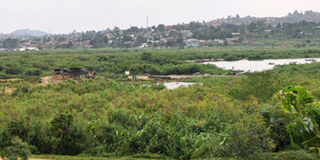Construction of Bukasa inland port starts next year

Part of the land where the Bukasa inland port is to be constructed on the shores of Lake Victoria. FILE PHOTO
What you need to know:
- The consultant envisages a raise in Uganda’s exportation of foods, animals, manufactured goods and miscellaneous articles to the international markets.
- Port Bell and Jinat are the two known ports on Lake Victoria on the Ugandan side but the government says Bukasa was chosen because it is spacious for expansion.
Kampala: The construction of a state of the art inland port at Bukasa on the shores of Lake Victoria will commence in June 2019, it has been revealed.
The revelation was made by Mr Jochen Scherer, the Projects Director of GAUF Engineering Company, a German firm that is doing the consultancy for the construction of the Bukasa port. He was speaking during a stakeholder’s workshop on the draft of the final master plan for the project at Kampala Sheraton Hotel.
Government through the Ministry of Works and Transport decided to construct a modern port at Bukasa to handle cargo transportation along the central corridor that will connect Uganda to Dar es Salaam through the Mwanza port on Lake Victoria.
While presenting the roadmap for the Bukasa Port construction that will be in three phases, Mr Scherer said that, GAUF engineering company will finalize the master plan by mid-April which will be followed by the final preliminary design by July 15, 2018. This is the first phase of the project.
“At the moment, we are finalizing the final master plan followed by the final preliminary design that will be out on 15th July 2018. With that done, we shall embark on the dredging and surcharging of the swamps to pave way for the start of physical construction in June 2019,” Mr Scherer said.
The construction works will kick-start the projects second phase that will be finalized in April 2022 with the infrastructure, administration unit and the shipping facilities called Roll-on/Roll-of (RoRo) in place.
The RoRo is the method by which vehicles and machinery are loaded onto ocean or lake shipping vessels for transport overseas.
The consultant said the phase three will see the construction of a multipurpose terminal by 2020, and Foreign Trade Zones and shipyards by the year 2030.
The total value of the modern port construction of Bukasa is yet to be made official as the government and the consultants are still harmonizing positions on the master plan.
The consultant told the participants that by the year 2030, the cargo outflow in terms of exports is expected to hit 411,315 tonnes while the cargo inflow (imports) would stand at 296,461 tonnes. However, at the start of 2020, the import cargo is forecasted to be about 333,266 tonnes while the export cargo would be 177,942 tonnes.
Connectivity
Ms Rhodah Babirye, the contract manager for Bukasa port in the Ministry of Works and Transport said the master plan caters for the construction for connection routes to the Standard Gauge Railway line and the Kampala-Jinja Expressway for the inland transportation of the cargo.
“The Bukasa port will have connection routes to the Kampala-Jinja Expressway and the SGR but we shall not wait for these two mega projects to take off. We shall work on the construction of the port and the routes joining it with the SGR and Kampala-Jinja Expressway so that when they are also completed, there is smooth transportation of goods,” Ms Babirye said.
The director for transport in the Ministry of Works and Transport Mr Benon Kajuna said that the Kenyan government is already on course with the construction of the SGR towards port Kisumu and the Tanzania having secured funds for their SGR from Dar es Salaam to Port Mwanza.
The construction of Bukasa port by Uganda is strategically planned to benefit from the accessibility of foreign cargo through Lake Victoria.
However, the participants expressed concern over the failure by the master plan to highlight how the tourism, security and environmental issues will be coopted into the project.
In her remarks, the Minister for Works and Transport, Ms Monica Azuba Ntege said that the key objective for the construction of Bukasa port is to solve the country’s rapidly growing sea transportation demand since there has been overdependence on the northern corridor where goods are accessed through Mombasa port in Kenya.
The minister also said Bukasa port will strategically link Uganda to the central corridor of Dar es Salaam hence easy connectivity to the Kampala Industrial Park through the Kampala-Jinja Expressway and SGR.
“This port will reduce on the cost of doing business and will improve competitiveness since there will be less reliance on the road especially Kampala-Malaba route since the trade merchandise shall be shipped from Kisumu or Mwanza and accessed cheaply at Bukasa,” Ms Ntege said.




